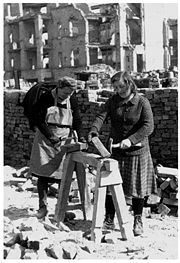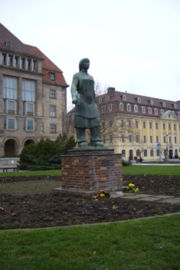
Trümmerfrau
Encyclopedia

World War II
World War II, or the Second World War , was a global conflict lasting from 1939 to 1945, involving most of the world's nations—including all of the great powers—eventually forming two opposing military alliances: the Allies and the Axis...
, helped clear and reconstruct the bombed cities of Germany
Germany
Germany , officially the Federal Republic of Germany , is a federal parliamentary republic in Europe. The country consists of 16 states while the capital and largest city is Berlin. Germany covers an area of 357,021 km2 and has a largely temperate seasonal climate...
and Austria
Austria
Austria , officially the Republic of Austria , is a landlocked country of roughly 8.4 million people in Central Europe. It is bordered by the Czech Republic and Germany to the north, Slovakia and Hungary to the east, Slovenia and Italy to the south, and Switzerland and Liechtenstein to the...
. With hundreds of cities having suffered significant bombing and firestorm
Firestorm
A firestorm is a conflagration which attains such intensity that it creates and sustains its own wind system. It is most commonly a natural phenomenon, created during some of the largest bushfires, forest fires, and wildfires...
damage through aerial attacks
Strategic bombing during World War II
Strategic bombing during World War II is a term which refers to all aerial bombardment of a strategic nature between 1939 and 1945 involving any nations engaged in World War II...
(and in some cases, ground fighting), and with many men dead or prisoners of war, this monumental task fell to a large degree on women, creating the term.
Degree of damage
Four million out of the sixteen million homes in Germany were destroyed during Allied bombings in World War II, with another four million damaged. Half of all school buildings, forty percent of the infrastructure, and many factories were either damaged or destroyed. According to estimates, there were about 400 million cubic metres of ruins.Removal of ruins
Between 1945 and 1946, the Allied powersAllies of World War II
The Allies of World War II were the countries that opposed the Axis powers during the Second World War . Former Axis states contributing to the Allied victory are not considered Allied states...
, in both West Germany
West Germany
West Germany is the common English, but not official, name for the Federal Republic of Germany or FRG in the period between its creation in May 1949 to German reunification on 3 October 1990....
and East Germany, ordered all women between 15 and 50 years of age to participate in the postwar cleanup. For this purpose, previous restrictive measures protecting women in the labor force were removed in July 1946. Recruitment of women was especially useful since at that time, because of the loss of men in the war, there were seven million more women than men in Germany.

Trümmerfrauen, both volunteers and regular workers, worked in all weather. They were organized in Kolonnen (columns) of ten to twenty people.
Later works and recognition
In the Soviet Occupation Zone, the Nationales Aufbauwerk (National Reconstruction Works) was founded, in order to coordinate the efforts of the Trümmerfrauen.In West Germany
West Germany
West Germany is the common English, but not official, name for the Federal Republic of Germany or FRG in the period between its creation in May 1949 to German reunification on 3 October 1990....
, the removal works continued as Notstandsarbeiten (State-of-emergency Works), until the cities were cleaned and the reconstruction could begin.
In both parts of Germany, as well as in Austria, the efforts of the Trümmerfrauen were recognized with numerous ceremonies, memorials, awards and exhibitions.
Their role was also considered important in changing post-war gender roles, though the concept of women as independent workers was taken up more eagerly in the official views of East Germany than in West Germany, where, once peace and economic prosperity was restored, a tendency reemerged in some parts of society to return women to their traditional family role only.
Aachen
On the 4th of October 2006, a weekly newspaper published the memories of the Trümmerfrau Elisabeth Stock (83) of which the following passage is cited:"...it were mostly women who shoveled their way through the rubble of Aachen's inner city that was totally destroyed; just for one bowl of soup from the Americans, we hammered and dragged debris all day long, even the pickaxe was part of our equipment, ...that's probably one reason why they put a memorial plaque for Aachen's Trümmerfrauen at the back of the townhall."
Berlin
Within the four occupied sectors of BerlinBerlin
Berlin is the capital city of Germany and is one of the 16 states of Germany. With a population of 3.45 million people, Berlin is Germany's largest city. It is the second most populous city proper and the seventh most populous urban area in the European Union...
approximately 10 per cent of the buildings were irreparably destroyed. In the central districts of Berlin Mitte, Kreuzberg
Kreuzberg
Kreuzberg, a part of the combined Friedrichshain-Kreuzberg borough located south of Mitte since 2001, is one of the best-known areas of Berlin...
, Friedrichshain
Friedrichshain
Friedrichshain is a part of Berlin's borough of Friedrichshain-Kreuzberg, and like Kreuzberg across the river it has its own distinct character, with the result that the new double name is hardly ever used outside government administration. From its creation in 1920 until Berlin's 2001...
, Prenzlauer Berg
Prenzlauer Berg
Prenzlauer Berg is a locality of Berlin, in the borough of Pankow.Until 2001, Prenzlauer Berg was a borough of Berlin; in that year it was included in the borough of Pankow....
, Tiergarten
Tiergarten
Tiergarten is a locality within the borough of Mitte, in central Berlin . Notable for the great and homonymous urban park, before German reunification, it was a part of West Berlin...
, and Wedding
Wedding
A wedding is the ceremony in which two people are united in marriage or a similar institution. Wedding traditions and customs vary greatly between cultures, ethnic groups, religions, countries, and social classes...
up to 30 per cent were destroyed. For this reason, the Trümmerfrauen had to work hard and their commitment gained widespread recognition:
In 1946, the Allied headquarters published a series of stamps, the so-called „Bärenmarken“, for the whole of Berlin. The graphic designers Alfred Goldhammer and Heinz Schwalbe created four images with symbols of the reconstruction, e.g. a bear with a brick, a bear with a shovel, a bear with a beam and a young oak tree in front of the ruins at Belle-Alliance square.
On 13 October 1950 the mayor of East-Berlin Friedrich Ebert
Friedrich Ebert
Friedrich Ebert was a German politician of the Social Democratic Party of Germany .When Ebert was elected as the leader of the SPD after the death of August Bebel, the party members of the SPD were deeply divided because of the party's support for World War I. Ebert supported the Burgfrieden and...
offered a newly built flat to a former Trümmerfrau in honour of her commitment. The flat was located in one of the terraces in the street which was formerly called Stalinallee and had been designed by Hans Scharoun
Hans Scharoun
Bernhard Hans Henry Scharoun was a German architect best known for designing the Berlin Philharmonic concert hall and the in Löbau, Saxony. He was an important exponent of Organic architecture....
.
Erika Heß, mayor of the district of Wedding, initiated the founding of a club for the Trümmerfrauen. Its members were invited for coffee and cake once a year and also received assistance when they needed to complete official business. In addition, excursions were organised.
Bremen
In May 2005, the Bremen organisation Friedensforum initiated a two-hour meeting under the motto Mother's Day - in a different way. Additionally to various activities like music performances or discussion groups etc., a Trümmerfrau and a pupil met for public discussion.Chemnitz
In 2001, due to an initiative of the 1998 founded club Verein figürliches Glockenspiel im Alten Rathaus-Turm zu Chemnitz e.V together with the support of numerous donators a carillon with a total number of 25 bells was being installed. Three times a day, the six figures, with the height of 1 metre, are coming out of the tower. One of them is shaped like a Trümmerfrau. The rubble woman has a brick on her knee which she holds with her left hand. In the right hand she has got a hammer. The figures were designed by the sculptor Johannes (Hannes) Schulze from Plauen and forged by the bell foundry Rudolf Perner Karlsruhe und Passau.External links
- "The Rubble Women" Blog account
- "Helene Lohe, my Trümmerfrau" Blog account

